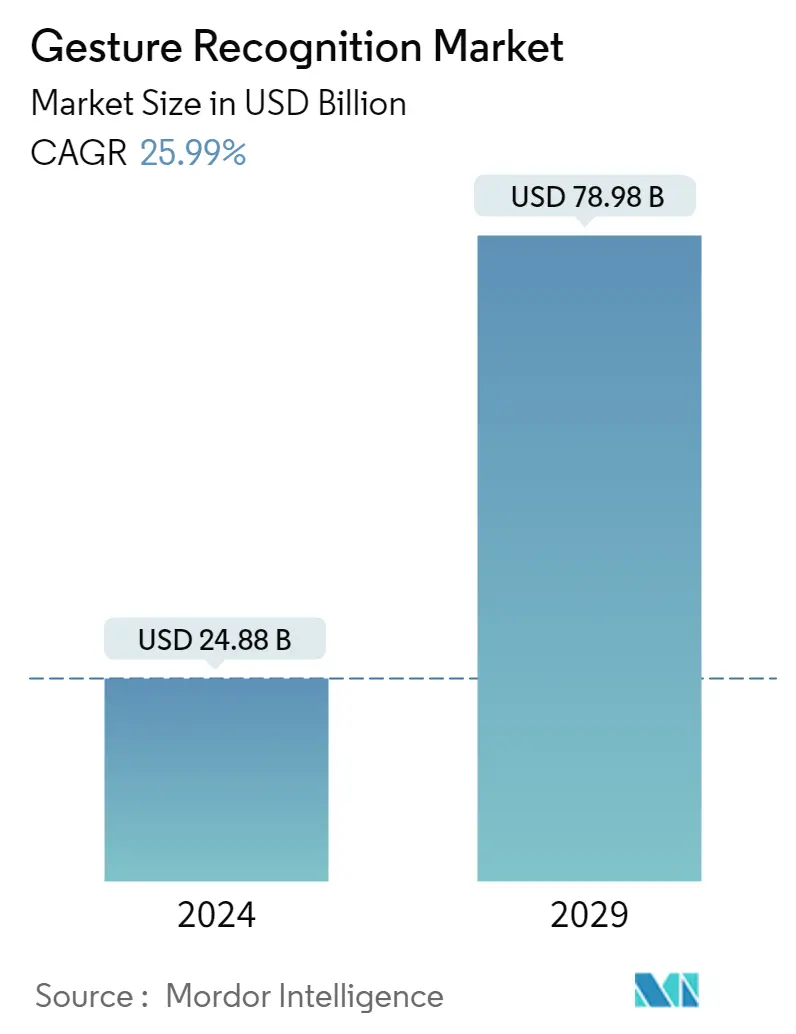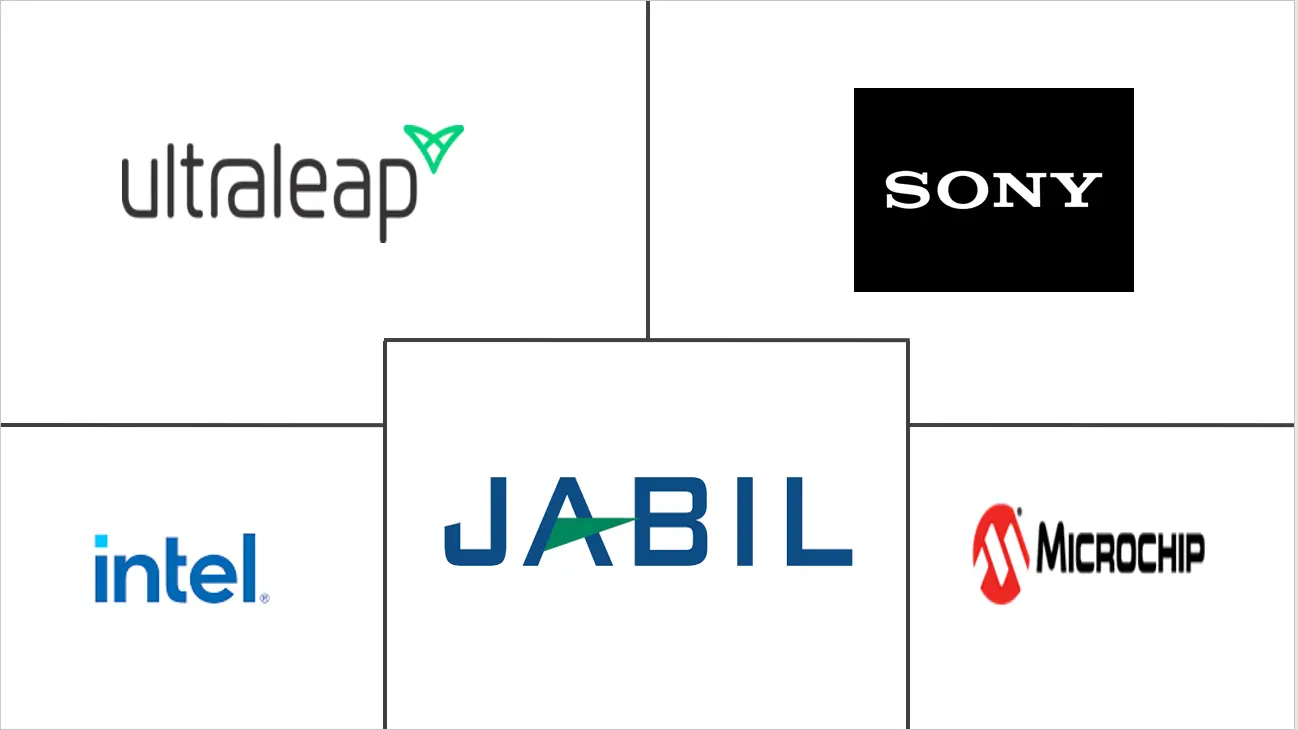Market Size of Gesture Recognition Industry

| Study Period | 2019 - 2029 |
| Market Size (2024) | USD 24.88 Billion |
| Market Size (2029) | USD 78.98 Billion |
| CAGR (2024 - 2029) | 25.99 % |
| Fastest Growing Market | Asia Pacific |
| Largest Market | North America |
Major Players
*Disclaimer: Major Players sorted in no particular order |
Gesture Recognition Market Analysis
The Gesture Recognition Market size is estimated at USD 24.88 billion in 2024, and is expected to reach USD 78.98 billion by 2029, growing at a CAGR of 25.99% during the forecast period (2024-2029).
- The development of artificial intelligence (AI) has given rise to gesture-recognition-based devices. Moreover, the recent technological advancements in the field of gesture recognition technology, coupled with increasing adoption among end-user industries, are analyzed to drive the market in the coming years.
- Gesture recognition technology is being increasingly implemented for human-device interaction due to an increased acceptance of gesture-enabled electronic devices across various industry verticals, for example, switching through television channels or radio stations. The use of gesture recognition is increasing in various sectors.
- One recent development in this area is the interaction of humans with machines by using hand gesture recognition. Another development is the use of hand gesture recognition to control computer applications.
- With continuous technological developments, the companies in the market studied have been manufacturing products incorporated with new and innovative features. Omron Corporation has developed gesture recognition technology by simultaneously recognizing the position, shape, and motion of a person's hand or finger by referencing a camera-recorded image.
- Moreover, gesture recognition technology is gaining substantial prominence among consumers and original equipment manufacturers due to increased user convenience when handling various electronic products. Manufacturers worldwide are focusing on innovation to add gesture recognition features in different consumer electronics, which has improved safety, reliability, and convenience. Further, the demand for touchless gesture recognition is governed by the increasing demand for superior user experience, ease of use, and rising digitization across several sectors.
- A gesture recognition application system comprises several key hardware and software components, all of which must be tightly integrated to provide a compelling user experience. Moreover, specialized algorithms subsequently interpret the processed data, translating the movements into actionable commands that a computer can understand. Subsequently, an application integrates these actionable commands with user feedback, which must be natural as well as engaging. Adding to the overall complexity of the solution, the algorithms and applications are increasingly being implemented on embedded systems, with limited processing, storage, and other resources.
- Additionally, the integration of advanced technologies such as artificial intelligence and machine learning in the gesture recognition ecosystem is further expanding the studied market. The proliferation of AI and ML technologies is causing paradigm shifts in Gesture recognition by offering a spectrum of feature-enriching applications in healthcare delivery, smart navigation, consumer electronics, augmented reality gaming, automation of homes, live video streaming, and virtual shopping.
Gesture Recognition Industry Segmentation
Gesture recognition is the conversion of human movements or signals to commands using a mathematical algorithm. It enables people to interrelate with machines in the absence of physical devices as an input mechanism to perform desired actions in a system. The technology interprets human gestures and movements, such as the movement of hands, fingers, arms, head, or the entire body. It allows users to operate and control devices merely with their gestures.
The gesture recognition market is segmented by technology (touch-based gesture recognition, touchless gesture recognition), end-user industry (automotive, healthcare, consumer electronics, gaming, aerospace and defense, and other end-user industries), and geography (North America, Latin America, Europe, Asia-Pacific, and Middle East and Africa).
The market sizes and forecasts are provided in terms of value USD for all the above segments.
| By Technology | |
| Touch-based Gesture Recognition | |
| Touchless Gesture Recognition |
| By End-user Industry | |
| Aerospace and Defense | |
| Automotive | |
| Consumer Electronics | |
| Gaming | |
| Healthcare | |
| Other End-user Industries |
| Geography*** | ||||||
| ||||||
| ||||||
| ||||||
| Latin America | ||||||
| Middle East and Africa |
Gesture Recognition Market Size Summary
The gesture recognition market is poised for significant growth, driven by advancements in artificial intelligence and increasing adoption across various industries. This technology is becoming integral for human-device interaction, enhancing user experience through touchless and gesture-enabled devices. The market is witnessing a surge in demand for innovative features in consumer electronics, with companies like Omron Corporation leading the way in developing sophisticated gesture recognition systems. These systems are being integrated into a wide range of applications, from healthcare and smart navigation to augmented reality gaming and virtual shopping, offering enhanced convenience and user engagement. The market's expansion is further supported by the integration of AI and machine learning, which are transforming gesture recognition capabilities and broadening their application scope.
The touch-based gesture recognition segment dominates the market, fueled by the widespread use of smartphones and laptops that incorporate these functionalities. As manufacturers continue to launch devices with advanced touch-based features, the market is expected to grow steadily. North America remains a key player in the market, with significant R&D investments and a strong presence of leading vendors. The automotive industry in the region is also contributing to market growth, with increasing demand for gesture-based interfaces in luxury vehicles. The United States, known for its technological advancements and high consumer electronics consumption, is a major market for gesture recognition technology. The competitive landscape is characterized by a few dominant players who are expanding their global presence through strategic collaborations and innovations, such as Ultraleap's integration of gesture recognition with digital signage solutions.
Gesture Recognition Market Size - Table of Contents
-
1. MARKET DYNAMICS
-
1.1 Market Overview
-
1.2 Industry Attractiveness - Porter's Five Forces Analysis
-
1.2.1 Bargaining Power of Suppliers
-
1.2.2 Bargaining Power of Buyers
-
1.2.3 Threat of New Entrants
-
1.2.4 Threat of Substitute Products
-
1.2.5 Intensity of Competitive Rivalry
-
-
1.3 Value Chain Analysis
-
1.4 Assessment of Impact of the COVID-19 on the Market
-
-
2. MARKET SEGMENTATION
-
2.1 By Technology
-
2.1.1 Touch-based Gesture Recognition
-
2.1.2 Touchless Gesture Recognition
-
-
2.2 By End-user Industry
-
2.2.1 Aerospace and Defense
-
2.2.2 Automotive
-
2.2.3 Consumer Electronics
-
2.2.4 Gaming
-
2.2.5 Healthcare
-
2.2.6 Other End-user Industries
-
-
2.3 Geography***
-
2.3.1 North America
-
2.3.1.1 United States
-
2.3.1.2 Canada
-
-
2.3.2 Europe
-
2.3.2.1 United Kingdom
-
2.3.2.2 Germany
-
2.3.2.3 France
-
-
2.3.3 Asia
-
2.3.3.1 China
-
2.3.3.2 Japan
-
2.3.3.3 India
-
2.3.3.4 Australia and New Zealand
-
-
2.3.4 Latin America
-
2.3.5 Middle East and Africa
-
-
Gesture Recognition Market Size FAQs
How big is the Gesture Recognition Market?
The Gesture Recognition Market size is expected to reach USD 24.88 billion in 2024 and grow at a CAGR of 25.99% to reach USD 78.98 billion by 2029.
What is the current Gesture Recognition Market size?
In 2024, the Gesture Recognition Market size is expected to reach USD 24.88 billion.

